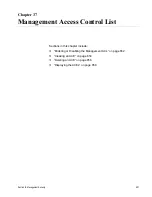
Chapter 37: Management Access Control List
652
Section IX: Management Security
Enabling or Disabling the Management ACL
This procedure enables and disables the management ACL. When
enabled, only those management stations specified in the ACL are
allowed to manage the switch remotely using the Telnet application
protocol or a web browser. When the feature is disabled, the management
software on the switch can be accessed remotely from any management
workstation.
Note
Do not activate the management ACL until you have specified the
access control entries (ACEs). Otherwise, the switch will discard all
remote management packets, making it impossible for you to
remotely manage the unit from a Telnet or web browser
management session. For instructions on how to add ACEs, refer to
“Creating an ACE” on page 654.
To enable or disable the Management ACL, perform the following
procedure:
1. From the Main Menu, type
5
to select System Administration.
The System Administration menu is shown in Figure 1 on page 32.
2. From the System Administration menu, type
7
to select Management
ACL.
The Management ACL Configuration menu is shown in Figure 244.
Figure 244. Management ACL Configuration Menu
3. Type
1
to select Management ACL Status and toggle the selection to
either Enabled or Disabled. The default setting is disabled.
Allied Telesis AT-9424T/SP - AT-S63
Marketing
User: Manager
11:20:02 02-Mar-2005
Management ACL Configuration
Configuring Management ACL
1 - Management ACL Status ........... Disabled
2 - Create Management ACL Entry
3 - Modify Management ACL Entry
4 - Delete Management ACL Entry
5 - Display All Management ACL Entries
R - Return to Previous Menu
Enter your selection?
Summary of Contents for AT-9400
Page 16: ...Figures 16 ...
Page 18: ...Tables 18 ...
Page 28: ...Preface 28 ...
Page 30: ...30 Section I Basic Operations ...
Page 60: ...Chapter 1 Basic Switch Parameters 60 Section I Basic Operations ...
Page 64: ...Chapter 2 Port Parameters 64 Section I Basic Operations Port Type The port type ...
Page 84: ...Chapter 2 Port Parameters 84 Section I Basic Operations ...
Page 124: ...Chapter 6 Static Port Trunks 124 Section I Basic Operations ...
Page 144: ...144 Section II Advanced Operations ...
Page 196: ...Chapter 10 File Downloads and Uploads 196 Section II Advanced Operations ...
Page 218: ...Chapter 11 Event Logs and the Syslog Client 218 Section II Advanced Operations ...
Page 242: ...Chapter 13 Access Control Lists 242 Section II Advanced Operations ...
Page 294: ...294 Section III IGMP Snooping MLD Snooping and RRP Snooping ...
Page 314: ...Chapter 19 MLD Snooping 314 Section III IGMP Snooping MLD Snooping and RRP Snooping ...
Page 318: ...318 Section IV SNMPv3 ...
Page 416: ...Chapter 21 SNMPv3 416 Section IV SNMPv3 ...
Page 418: ...418 Section V Spanning Tree Protocols ...
Page 470: ...470 Section VI Virtual LANs ...
Page 520: ...Chapter 26 Multiple VLAN Modes 520 Section VI Virtual LANs ...
Page 532: ...Chapter 27 Protected Ports VLANs 532 Section VI Virtual LANs ...
Page 546: ...546 Section VII Internet Protocol Routing ...
Page 560: ...560 Section VIII Port Security ...
Page 568: ...Chapter 30 MAC Address based Port Security 568 Section VIII Port Security ...
Page 586: ...Chapter 31 802 1x Port based Network Access Control 586 Section VIII Port Security ...
Page 588: ...588 Section IX Management Security ...
Page 610: ...Chapter 33 Encryption Keys 610 Section IX Management Security ...
Page 650: ...Chapter 36 TACACS and RADIUS Protocols 650 Section IX Management Security ...
Page 660: ...Chapter 37 Management Access Control List 660 Section IX Management Security ...
Page 668: ...Index 668 ...






























